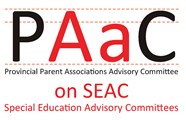The development of the annual budget and review of financial statements is an on-going process and SEAC should be kept informed about the process and have an opportunity to participate and provide advice to the Trustees. Special education funding is complex and SEAC members need to understand how school boards are funded for all students, as well as the components of the Special Education Grant, intended to cover the incremental costs of special education programs and services.
Each year the Ministry of Education releases information on the school board funding, including special education grants and related guidelines. This information can be found on the Ministry website at: http://www.edu.gov.on.ca/eng/policyfunding/funding.html
There are currently 6 components to the Special Education Grant and SEAC members need to be familiar with all of them. The components are:
- Special Education Per Pupil Amount (SEPPA)
- Differentiated Special Education Needs Amount (DSENA)
- Special Equipment Amount (SEA)
- Special Incidence Portion (SIP)
- Behaviour Expertise Amount (BEA)
- Facilities Amount (FA)
In addition, Measures of Variability (MOV) and the Special Education Statistical Prediction Model (SESPM) are parts of the DESNA. PAAC on SEAC recommends that orientation and on-going training for SEAC members includes information on special education funding.
Effective Practices to support SEAC participation in budget planning for special education programs and services include:
- Providing SEAC members with orientation and training regarding financial statements, the Special Education Grant, revenues and expenditures.
- Providing timely information on the Special Education Grant each year when Ministry of Education releases the grant regulations.
- Inviting SEAC members to participate in Budget Committee or working groups.
- Providing regular updates on Financial Statements and the budget process at SEAC meetings.
- Analyzing special education budget information, program staffing and statistical information about students with special education needs.
- Planning a SEAC presentation to Trustees as part of public consultation on the annual school board budget.
Effective Practices to support financial literacy of SEAC members include:
- Sharing of Ministry of Education resource materials regarding special education funding, including Power Points and Webinars, with SEAC members.
- Providing SEAC members with written materials about special education funding, including definitions of key terms, in SEAC Orientation Manuals.
- Regular presentations on the school board budget and financial statements at SEAC meetings.
- Presenting financial information to SEAC members in easy to understand language with visuals and graphics.
Under Regulation 464/97, SEAC members are to have the opportunity to participate in the special education budget planning process. Each school board has a different process for the development of budgets, often including the establishment of a budget committee or ad hoc group. PAAC on SEAC recommends that SEAC members be kept informed of the budget process and timelines.
